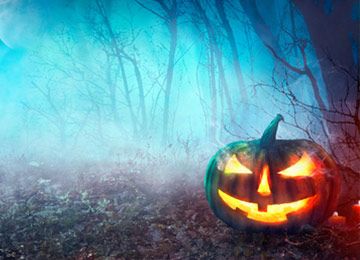
Note: this article was originally published on 10/22/2019
Halloween is a beloved holiday, filled with costumes, trick-or-treating, spooky tales, and plenty of candy. But have you ever wondered where these traditions came from? We’ll explore the rich history and evolution of the holiday, unveiling fascinating Halloween facts that are sure to impress.
Halloween Facts About the Origins and Evolution of the Holiday
The story of Halloween begins long before modern costumes and candy. It stems from ancient Celtic rituals, blending with Roman, Christian, and local customs over time to create the early framework for the holiday. Let’s dive into the origins that gave birth to this spooky celebration.
1. Halloween’s Name Comes from a Scottish Poem
The word "Halloween" first appeared in a 1785 poem titled “Halloween” written by the Scottish poet Robert Burns. The poem itself is a reflection on the ancient customs and spirit of the holiday, capturing the eerie and mystical atmosphere associated with the night. Burns’ work is notable for evoking the traditions of Scottish and Celtic culture, showcasing themes of superstition, the supernatural, and the connections between the living and the dead.
This term itself is a blend of two words: “Hallow,” meaning holy person or saint, and “evening," or the night before. Halloween refers to the evening before All Saints’ Day, a time to honor the saints and to connect with spirits of the dead. While the holiday has evolved over time, its connection to the supernatural remains central in many of today’s traditions.
2. Halloween Traces Back to Ancient Celtic Festival of Samhain
The origins of Halloween can be traced back over 2,000 years to the ancient Celtic festival of Samhain, celebrated by the Celts in what is now Britain and northern France. This festival marked the end of the harvest and the beginning of winter, a time when it was believed the boundary between the living and the dead was thin.
As part of the celebrations, the Celts built huge bonfires, made animal sacrifices, and wore costumes made of animal hides to ward off spirits, a practice that may have eventually influenced the modern custom of wearing costumes to protect oneself from wandering spirits on Halloween night. Celtic priests, also known as Druids, were believed to have the ability to communicate with the dead, foretelling the future during this sacred time.
Some of these practices, including the use of fire and animal offerings, were rooted in ancient festivals designed to protect communities from malevolent forces. As the festival ended, people would take embers from the bonfires back to their homes to light their hearth fires, symbolizing warmth and continuity.
3. Roman Traditions Shaped Modern Halloween Customs
By 43 CE, the Romans had conquered the Celtic lands, bringing with them their own traditions. The Romans celebrated two key holidays around late October: Feralia, a day to honor the dead, and Pomona, a festival dedicated to the goddess of fruit and trees.
Over time, these Roman holidays combined with Samhain, influencing modern Halloween traditions. For instance, the apple, a symbol of Pomona, became associated with the popular Halloween game of bobbing for apples, linking it to the harvest season.
Facts About Halloween's Cultural Transformation and Spread
Halloween’s journey didn’t end with its origins; it transformed as it crossed continents and cultures. From early American practices to the influence of Irish immigrants, this section reveals more Halloween fun facts about the community-oriented celebration we know today.
4. The Catholic Church Helped Shape Halloween’s Religious Overtones
In 609 CE, the Catholic Church introduced All Saints’ Day on November 1, honoring the saints. This holiday was also known as All Hallows' Day, and the evening before became known as All Hallows’ Eve, which was later shortened to Halloween.
As part of this Christianization of the holiday, the church also instituted All Souls' Day on November 2 to honor the souls of the dead. Many secular practices like bonfires, costumes, and parades were incorporated into these religious observances to help the church gain more followers and replace pagan customs. Over time, some of these practices were even twisted into what would later be known as Satanic symbols, which became associated with Halloween’s more macabre aspects during later periods.
5. Halloween Had a Slow Start in Colonial America
Early colonial America didn’t embrace Halloween. The Puritans, who were dominant in the northern colonies, viewed the holiday as a Catholic and pagan tradition, and thus, did not participate.
However, in Catholic Maryland and the southern colonies, Halloween remained a festive occasion, often celebrated with “play parties,” or community gatherings around bonfires where people would dance, sing, and share ghost stories. These early celebrations helped lay the groundwork for Halloween’s later popularity across the country.
6. Irish Immigrants Pioneered Modern Halloween Traditions
The Halloween we know today truly began to take shape in the second half of the 19th century, as large waves of immigrants, particularly Irish families fleeing the Potato Famine, arrived in America. These Irish immigrants brought with them their Halloween customs, such as carving faces into turnips (which evolved into the pumpkin jack-o’-lanterns) and dressing in costumes.
By the early 20th century, Halloween had become a completely secular celebration, shedding its religious roots and becoming a fun, community-driven event focused on entertainment and togetherness.
More Halloween Facts and How You Can Embrace the Spirit of the Season
As you explore these and other Halloween facts, you quickly realize this holiday is far more than just a fun, candy-filled occasion. Its deep historical roots trace back through religious transformations and cultural shifts that have shaped the traditions we celebrate today. Whether you're carving a pumpkin, dressing in costume, or sharing ghost stories, you're participating in a tradition that has evolved over centuries.
If you’re inspired by the rich history of Halloween and its connections to spirituality and ritual, consider deepening your understanding by joining a community that embraces both the light and dark aspects of life. The Universal Life Church offers a unique opportunity to officiate ceremonies, perform rituals, and guide others through life’s milestones. Become a minister and embrace your calling to make an impact today!



